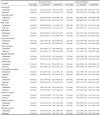| Korean J Health Promot > Volume 19(3); 2019 > Article |
|
ABSTRACT
Background
Methods
Results
REFERENCES
Figure┬Ā1
The distribution of energy drink consumption frequency in boys and girls. Differences between boys and girls were significantly different (P<0.001), calculated by Rao-Scott chi-square test.

Table┬Ā2
General characteristics according to energy drink consumption in boys and girlsa

Values are presented as mean┬▒standard error or number (%).
aDifferences between general characteristics and energy drink consumption in boys and girls were calculated by generalized linear model (GLM) for continuous variables and by Rao-Scott chi-square test for categorical variables, and all P values were less than 0.001, except for that of residential area in girls (P=0.001).
Table┬Ā3
Association between energy drink consumption and dietary- or lifestyle-related behavior in boys and girls

Values are presented as odds ratio and 95% confidence interval, calculated by multivariate logistic regression analysis.
Abbreviation: ref., reference.
aDependent variables: fruit intake Ōēź3 vs. <3 times/wk (ref.); vegetables intake Ōēź1 vs. <1 time/d (ref.); milk intake Ōēź5 vs. <5 times/wk (ref.); soda intake Ōēź3 vs. <3 times/wk (ref.); sweet-drink intake Ōēź3 vs. <3 times/wk (ref.); fast food intake Ōēź1 vs. <1 time/wk (ref.); skipping breakfast Ōēź3 vs. <3 days/wk (ref.); underweight vs. normal weight (ref.); overweight and obesity vs. normal weight (ref.); smoking yes vs. no (ref.); drinking yes vs. no (ref.); moderate exercise Ōēź5 vs. <5 times/wk (ref.); vigorous exercise Ōēź3 vs. <3 times/wk (ref.); and muscular exercise Ōēź3 vs. <3 times/wk (ref.).
bAdjusted for age, grade, academic achievement, paternal education, maternal education, economic status, residential area and residential type.
Table┬Ā4
Association between energy drink consumption and mental health-related behavior in boys and girls

Values are presented as odds ratio and 95% confidence interval, calculated by multivariate logistic regression analysis.
Abbreviation: ref., reference.
aDependent variables: sleep hours Ōēź8 vs. <8 hours/d (ref.); sleep quality satisfactory vs. non-satisfactory (ref.); excessive stress yes vs. no (ref.); sadness or depression yes vs. no (ref.); suicide ideation yes vs. no (ref.); perceived health yes vs. no (ref.); perceived happiness yes vs. no (ref.).
bAdjusted for age, grade, academic achievement, paternal education, maternal education, economic status, residential area and residential type.
-
METRICS

-
- 6 Crossref
- 0 Scopus
- 1,019 View
- 10 Download
- Related articles





 PDF Links
PDF Links PubReader
PubReader ePub Link
ePub Link Full text via DOI
Full text via DOI Download Citation
Download Citation Print
Print


